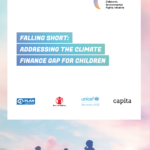The Healthy and Environment-friendly Youth (HEY) Campaign has launched a series of joint interviews with young people from across the world on climate change and health. This is an interview with Mansi from India and Rayon from Jamaica.
Mansi Sharma is a 19-year-old HEY Campaign Ambassador, medical student and advocate for menstrual hygiene that loves dancing, listening to loud music, and making portraits of celebrities.
Rayon Brown is a 23-year-old HEY Campaign Ambassador, student from the Caribbean Maritime University, Jamaica aiming to be an eco-friendly agricultural entrepreneur.
YOU IN ONE WORD?
Mansi: Minimalist
Rayon: Oceanographer (Having high hopes that one day I will able to study the marine environment and its ecosystems)
DESCRIBE NATURE IN YOUR COUNTRY : THE PLACES AND SPECIES YOU CHERISH, VALUE, WANT TO PROTECT?
Mansi: India’s outstanding diversity of religions, languages and cultures is unique and unmatched. It has beautiful green crops that fill our landscapes with greenery. The Himalayas decorate India like a majestic crown. The geographical features of India includes its natural wonders, heritage sites and must see places such as the Great Indian Thar Desert, snow capped Himalayas, Nilgiri mountains, beautiful lakes of Ladakh and peaks of western ghats, famous waterfalls like the Jog Falls and Hoggenakal Falls.
India is home to several well-known large mammals like the Asian Elephant, the Bengal Tiger, the Asiatic Lion, the Leopard and the Indian Rhinoceros, which are very important to Indian culture and are associated with deities. The popularity of such animals aid in conservation efforts and they are increasingly important for wildlife and ecotourism. There are 400 wildlife sanctuaries and 80 national parks in India, which is home to several endangered and wild species such as the beautiful snow leopard, king cobra and the blind dolphin, which is the national aquatic animal of India. As the name suggests these are essentially blind freshwater fish, which I cherish, wishing to support their saving programme started by WWF in 2001. These animals being on the brink of extinction need extreme action to save them, and for the coming generations to experience and savour them.
Rayon: From the rolling green hills to transparent turquoise water and blossoms as bright as a rainbow, Jamaica is simply stunning. Take a look around you and you’ll notice the chirping of birds, many indigenous to Jamaica, or even spot the Doctor Bird, our national bird. Among Jamaica’s most prized natural treasures are the vast diversity of flowering plants and a surprising array of wildlife found nowhere else in the world. All these features combine to create our unique ecosystem. Mother Nature is pretty much in love with Jamaica if you ask us.
We have about 200 resident bird species and more endemic species than any other Caribbean island. Of these, 25 species and 21 subspecies are found nowhere else. Our national bird, the Red-Billed Streamertail Hummingbird, affectionately called the Docto Bid or Swallow-Tail Hummingbird (Trochilus polytmus), lives only in Jamaica. Its image has become a widely utilized national symbol. I cherish and love this species of bird, which is very valuable to me as the national bird. Because you rarely get to see it even when you reside in Jamaica it is a top priority for me to protect the ecosystem they live in. Additionally, there are over a dozen different kinds of small frogs, one hundred (100) different butterflies and twenty-five (25) species of harmless bats.
UNFORTUNATELY, OUR ENVIRONMENT IS CHALLENGED BY HUMAN ACTIVITIES AND INAPPROPRIATE BEHAVIORS. TELL US WHAT FRUSTRATES YOU THE MOST WHERE YOU LIVE, CAN YOU THINK OF ANY SOLUTION TO SOLVE THESE PROBLEMS?
Mansi: For me: plastic toxicity. Among one of India’s most intractable problems, such as water pollution, traffic congestion and air pollution, plastic littering frustrates me the most. This is because we are the direct cause of this by not completely avoiding the use of plastic bags, straws, cups and plates. These non-degradeables when disposed, plague our landfills or even worse, our water bodies.
Swachh Bharat Mission or Clean India Mission was a country-wide campaign aiming for a litter free India by October 2019, but had a very minimal effect. There was a time when India had a very low plastic consumption, which is now seen to be going up steadily and could double up within a decade or less. I believe that this non-degradable plastic could be recycled to make Eco-tech houses like the ones made with PET bottles, clothing and even sofas and pillows! As a young activist, I would like to initiate programmes to incorporate recycling ideas in order to put the already produced plastic to good use and diminish littering on the lands of our Earth. I believe that reducing waste, recycling, and proper waste disposal are keys to cleaner environments and healthier citizens.
Rayon : And for me: mining in the Cockpit Country. It is all being exposed now and accounts for the behaviour of the private owners who feel they will be successful in this battle, which will destroy Jamaica’s priceless ecosystem and remove residents from their homes, farming, and other businesses for some more bauxite. Jamaica is one of the high-risk countries that may suffer greatly from climate change, decreasing our potential food supply and water resources, so it is imperative that every acre of land be used as wisely as possible guided by an updated National Environmental Impact Assessment study and the recently announced national spatial plan. This is a shared solution I observed but also acknowledged. If we have enough technological and industrial capacity to process bauxite to higher levels of value-added products, then the Government could consider importing bauxite for this reason without mining in the Cockpit Country.
Besides, I am concerned about ocean acidification, which is sometimes called “climate change’s equally evil twin” and for good reason: it’s a significant and harmful consequence of excess carbon dioxide in the atmosphere that we don’t see or feel because its effects are happening underwater. At least one-quarter of the carbon dioxide (CO2) released by burning coal, oil and gas doesn’t stay in the air, but instead dissolves into the ocean. Since the beginning of the industrial era, the ocean has absorbed some 525 billion tons of CO2 from the atmosphere, presently around 22 million tons per day.
WE ARE IN 2030, POLITICAL AND ECONOMIC LEADERS HAVE TAKEN ACTION ON CLIMATE. SHARE YOUR WISH LIST OF WHAT HAS CHANGED (IN YOUR COUNTRY OR THE WORLD).
Mansi: Before time travelling into 2030, I would like to backtrack into the 17th century, when India was known as the “golden bird”. This was because it was by far the richest country in the world, known for its spices, cotton, iron weapons, textiles, abundant natural resources and home to 13,000 species of mammals and birds. Tigers, our national animal, were more than 40,000, and found in the wild forests of India before industrialization and colonization had hit nature. This is now the India of my dreams.
In my wish list of a changed India in 2030, I wish to witness the same ecologically flourishing land that I have read about in history books. I wish to freely drink from the water bodies without worrying about toxicity and breath in the fresh air without having to wear any filter masks. I hope that the future generation will get to experience most flora and fauna species, I had the fortune to savour as a child. This is possible if the growing industrialization doesn’t replace the greenlands with skyscrappers and natural forests with conservation centres and sanctuaries. The animals, birds and fish can live in their natural habitats as freely as we live in our homes, without plastic choking our throats and soot from factory chimneys in the form of carbon emissions degrading our ozone layer.
Rayon: I would like to witness two things. Firstly, green logistics: Supply chain management practices and strategies that reduce the environmental and energy footprint of freight distribution. It focuses on material handling, waste management, packaging, and transport. Secondly, cut carbon emissions, by regrowing mangroves, seagrass beds, and marshes, known as blue carbon. If we did, over hundreds of thousands of years, carbon dioxide in the atmosphere and ocean would stabilize again. Well, maybe technologies could help, not that I believe that a form of “geoengineering” could be achieved by 2030 but the idea could be researched and examined more deeply with that time frame. It would be ideal to develop technologies that can help us reduce atmospheric carbon dioxide or the acidity of the ocean more quickly or without needing to cut carbon emissions very drastically. But such solutions would require us to deliberately manipulate planetary systems and the biosphere (whether through the atmosphere, ocean, or other natural systems).
Another idea is to remove carbon dioxide from the atmosphere by growing more of the organisms that use it up: phytoplankton. Adding iron or other fertilizers to the ocean could cause man-made phytoplankton blooms. This phytoplankton would then absorb carbon dioxide from the atmosphere, and then, after death, sink down and trap it in the deep sea. However, it’s again unknown how this would affect marine food webs that depend on phytoplankton, or whether this would just cause the deep sea to become more acidic itself.






